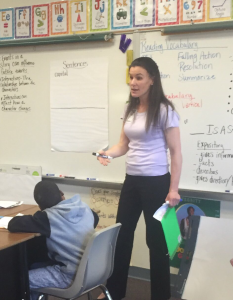 Before I begin, I know that very few people truly love editing. It’s one of those things that is black and white but seems to have so many rules and exceptions that leave most of us confused. From teaching editing skills myself, I am keenly aware of how many rules I didn’t know well enough to teach. I know (at least I’m pretty sure!) I must have learned these rules in elementary school, and, over time, they became automatic to where I didn’t have to rely on remembering the rules to know where to put commas, what actually makes a sentence, when to double consonants when adding an ending, etc. I just did it. Now, as a teacher, I HAVE to go back and read the rules. Why does this need a comma? Why does the “c” change sounds within a word? I have to face the fact that if I want to teach these skills well, I need to remember every nuance of the grammar rules. My all time favorite resources for brushing up on the rules are Jeff Anderson’s books: Everyday Editing and Mechanically Inclined.
Before I begin, I know that very few people truly love editing. It’s one of those things that is black and white but seems to have so many rules and exceptions that leave most of us confused. From teaching editing skills myself, I am keenly aware of how many rules I didn’t know well enough to teach. I know (at least I’m pretty sure!) I must have learned these rules in elementary school, and, over time, they became automatic to where I didn’t have to rely on remembering the rules to know where to put commas, what actually makes a sentence, when to double consonants when adding an ending, etc. I just did it. Now, as a teacher, I HAVE to go back and read the rules. Why does this need a comma? Why does the “c” change sounds within a word? I have to face the fact that if I want to teach these skills well, I need to remember every nuance of the grammar rules. My all time favorite resources for brushing up on the rules are Jeff Anderson’s books: Everyday Editing and Mechanically Inclined.
Recently, I was asked to model editing lessons in fourth grade. After reading student work samples and looking at their data, I decided to start with the basics of a sentence. A sentence has to have a subject and a verb. In addition, it must express a complete thought. I began by asking students what makes a sentence a sentence. They were able to tell me bits and pieces: capital letter, ending punctuation, subject, predicate. The truth is (I’m sure you can relate!) the students might have been able to list these things that “made a sentence,” but did they really understand what they meant? Not fully. When I asked the students what a subject was, I realized we didn’t have a firm grasp on this idea. So, the lesson begins.
There are four elements to strong teaching, in any subject: modeling, scaffolding, processing time, and assessment with feedback. Here’s what those elements looked like in this particular lesson:
Model: I began by showing sentences and identifying the subject and the verb in each. I started with two word sentences such as: Sheila cried. Then I added words and repeated the idea of finding the subject and the verb (Sheila cried loudly). We discussed how you don’t need loudly for it to be considered a sentence, but it sure added description to the sentence. In addition to discussing action verbs, I also taught the students about linking verbs. Linking verbs seemed to be a new concept for the students, but one they picked up on quickly.
Scaffolding and Processing: Students were given a sentence with each word written on a different index card so that they could arrange the word to form a sentence. I wrote each sentence in a different color sharpie since there were three students per desk group. This way, they wouldn’t get mixed up and students could help each other if needed. First, students had to arrange the words to make the sentence. They had to read their sentence to themselves and identify the subject and verb. Once everyone in the group was done processing, they had to share with their group members. Each member had a different sentence, so they had to do their own work, but they were able to get validation and help from those in their group. It’s support for them, but each student wound up doing this activity three times!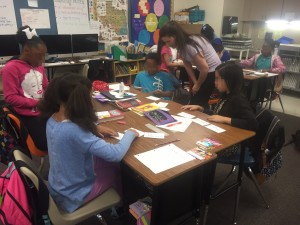
Assessment/Feedback:While the students were processing through the activity, I was circulating and asking questions. It’s important to circulate in order to help students who are confused or who need help, but it’s also important to ask questions. When you ask students questions about what they are doing, you get to know their thought process. Are they thinking deeply or are they mimicking the activity and appearing to understand? As you walk around you should be taking notes on a checklist or paper about how the students are doing and what they need to understand. Feedback is necessary. This doesn’t mean you should walk around and just randomly praise everyone, but be specific in what is going well and what their next step in learning should be.
I brought all the students’ attention back to the front and asked all the students with the “red sentence” to read it out loud. Then asked them to put one hand on the subject and then the verb. I did this for the other two colored sentences as well.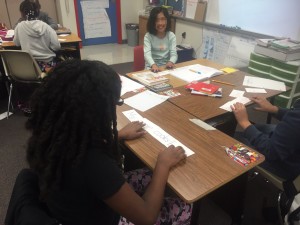
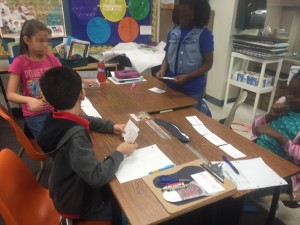
Model: I wanted to move from one sentence out of context to actually looking at a piece of writing. I shared my writing with the students, and I modeled editing my paper for complete sentences. I read each sentence to the students. After each sentence I did a think aloud that sounded something like this, “I see that I have used a capital letter at the beginning and a period at the end. That’s good. I need to make sure I have a subject. In this sentence, my subject is my dog. I also need to make sure there is a verb. I used ran for my verb. This sentence is complete.” I went through the entire paper this way modeling for the students. Sometimes, sentences were incomplete, and I modeled how I wanted them to fix this mistake. About halfway through the paper, it turned into more of an interactive shared write, since students were chiming in and helping me fix my mistakes. Isn’t it funny how they can find everyone else’s mistakes and not their own?
Processing: Next, students went into their own drafts and emulated the process I had shown them to edit their own papers for complete sentences. When they felt they were complete, they traded papers with a peer and they searched for complete sentences as well.
Assessment/Feedback: As students worked on their papers, I monitored again. I helped students get focused and wound up taking a small group to the back to reteach the idea of sentences.
Overall the lesson went well. Sometimes in fourth grade we are convinced they already know what makes a simple sentence, but I want to make sure. On the next two visits I will work with the students to expand upon this idea, talking about complete thoughts and compound sentences. But first, I needed to make sure we had a solid foundation.
Here is the actual lesson plan: WritingSentences
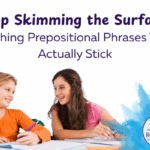

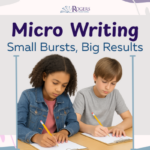
Thank you so much for all the amazing info! Excited to be here in training with you today and all your wealth of info!
Thank you so much for all the information! Your full of so much knowledge and I’m trying to soak it all in today! Thank you for being here today! 🙂